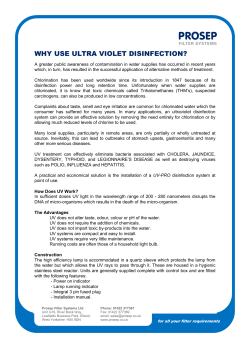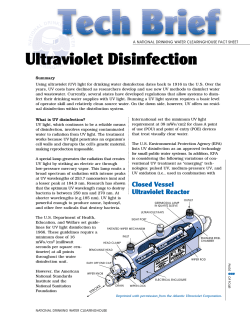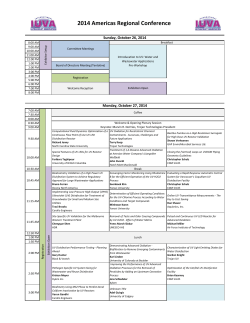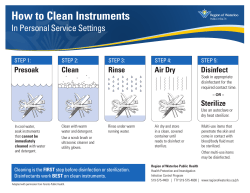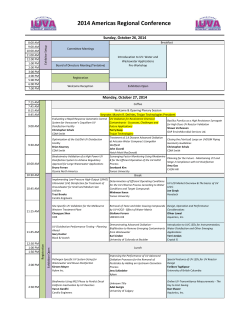
What is UV? with the greatest amount of inactivation occurring
31-014-0410 Ultraviolet (UV) Disinfection in Drinking Water Treatment What is UV? Ultraviolet light (UV) is a form of energy called electromagnetic radiation. UV light is a small part of the entire electromagnetic spectrum made up of other types of radiation including visible light, xrays, radio waves, and microwaves, all at different wavelengths. UV light is electromagnetic radiation with wavelengths in the range of 100400 nanometers (nm). In contrast visible light is in the range of 400-700 nm. So UV light is not visible. with the greatest amount of inactivation occurring around 260 nm. For UV light, inactivating microorganisms is different than killing them. UV light doesn’t damage or destroy cellular structures like chemical disinfectants do (e.g., chlorine, ozone, chlorine dioxide). Rather, UV light prevents microorganisms from reproducing by damaging their deoxyribonucleic and ribonucleic acids (DNA and RNA). Microorganisms that cannot reproduce cannot infect and are thereby inactivated. In general, viruses are most resistant to UV disinfection compared to protozoan cysts (e.g., Cryptosporidium) and bacteria. How is UV used in Drinking Water Treatment? Figure. The Electromagnetic Spectrum. Source: http://www.sentinelarchiving.com/ARTICLES/electromag.htm How does UV Disinfection Work? UV light has germicidal properties that were discovered as early as 1887. Much research has been conducted that shows UV light at certain wavelengths can inactivate microorganisms (references 1, 2). UV light with wavelengths from 200-300 nm inactivates most microorganisms, Using UV light in drinking water treatment requires the generation and application of UV light in a way to maximize its effectiveness. All UV drinking water treatment devices require power to generate UV light. When a UV lamp is turned on, mercury in the lamp is “excited” and takes on energy. The mercury quickly discharges that extra energy in the form of UV light. Mercury is a necessary component of UV lamps because it emits light in the germicidal wavelength (200-300 nm). However, there are new UV lightemitting-diodes (UV LEDs) being developed that do not use mercury and show promise as effective UV disinfection devices (References 3, 4). A UV device used in drinking water treatment typically consists of a UV lamp, a clear quartz sleeve to protect the lamp and allow the UV light to penetrate the water, and in some cases a means to measure the intensity of UV light produced. Having the ability to measure UV light intensity is U.S. Army Public Health Command (Provisional) Aberdeen Proving Ground, MD 21010-5403 Commercial 410-436-3919 or DSN 584-3919 Email: Water.Supply@amedd.army.mil http://chppm-www.apgea.army.mil/dehe/pgm31 important since certain water quality characteristics can reduce intensity and UV intensity degrades the more the lamp is used. Additionally, the UV device is designed to ensure all the water being treated is channeled through the device as close to the quartz sleeve as possible to ensure the water receives the longest amount of exposure possible at the maximum UV intensity. UV devices work best when treating clear water, so UV devices are typically located after filtration treatment processes. The effectiveness of UV light is highly dependent on the turbidity, or cloudiness, of the water and any color present in the water. In highly turbid or colored water the UV light won’t be able to penetrate through the water. A well-designed UV device will incorporate indicators of operation to measure the UV intensity, or UV dose, provided to the water and will also include indicators of lamp function (on/off). UV devices can be scaled to fit any size or type of drinking water treatment need, from small handheld devices to large systems capable of treating millions of gallons per day. A number of commercially available water treatment systems designed to fulfill the needs of the military squadsized unit incorporate UV as a disinfectant. These water purifiers are meant to be portable and therefore present inherent risk of breakage or damage to the UV device during transport. Care must be exercised when transporting a UV device and they should be closely inspected prior to operation to ensure no damage has occurred. A significant disadvantage of using UV for disinfection is its inability to provide a residual. If UV disinfected water is to be stored a chemical disinfectant such as chlorine or iodine, capable of providing a long-lasting disinfectant residual, should be added to the stored water to prevent recontamination. Are there any Health Risks from using UV? There are three potential health risks associated with using UV devices – formation of disinfection byproducts; mercury exposure due to UV lamp breakage; and direct exposure to UV light generated by the UV device. All these potential health risks are generally considered minimal. While there is evidence that UV can produce disinfection byproducts, UV produces far fewer disinfection byproducts compared to other chemical disinfectants typically used in drinking water treatment (e.g., chlorine, ozone, chlorine dioxide), Disinfection byproducts may cause adverse health effects if consumed in sufficient quantities for long periods of time. Most UV lamps used in drinking water treatment contain between 5 milligrams (mg) and 400 mg of mercury. There is a concern if a UV lamp breaks during operation the mercury could enter the treated water and be ingested. Most UV devices have safety mechanisms installed to alarm or stop treatment or water flow if a UV lamp breaks or loses power for any reason. Additionally, if the quartz sleeve is not damaged or broken it may prevent mercury from entering the water if the lamp breaks. While this is a concern, the potential health risk from ingesting mercury is low. The health risks from direct exposure to UV from sunlight are well documented. There is a concern that a user could be exposed to UV light when using or maintaining a UV device. However, this poses a slight risk as UV devices are designed to operate in enclosed vessels and include safety mechanisms to prevent UV light exposure during maintenance. ___________________________ References 1. Clarke, S., Bettin, W. “Ultraviolet Light Disinfection in the Use of Individual Water Purification Devices”, Defense Technical Information Center, http://www.dtic.mil/dtic/index.html (accessed 18 Sep 2009). 2. Chang, J. et.al. (1985), “UV inactivation of pathogenic and indicator organisms”, Applied Environmental Microbiology, Vol. 49, No. 6, pp. 1361-1365. 3. Mori, M. et.al. (2007), “Development of a new water sterilization device with a 365-nm UV-LED”, Medical & Biological Engineering & Computing, Vol. 45, No. 12, pp. 1237-1241. 4. Vilhunen, S., Sarkka, H., Sillanpaa, M. (2009), “Ultraviolet light-emitting diodes in water disinfection”, Environmental Science and Pollution Research International, Vol. 16, No. 4, pp. 439-442.
© Copyright 2025
